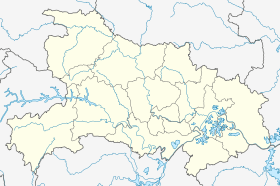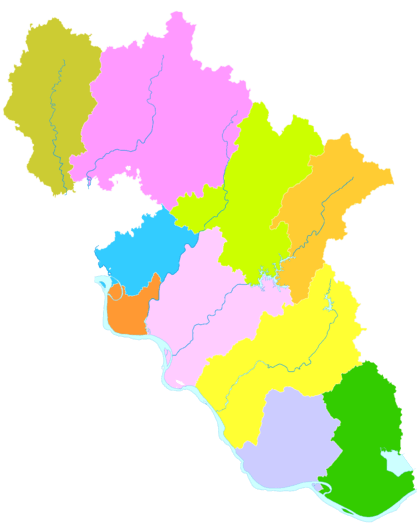Huanggang
| Huanggang 黄冈市 | |
|---|---|
| Prefecture-level city | |
.png) Location of Huanggang City jurisdiction in Hubei | |
 Huanggang Location of the city centre in Hubei | |
| Coordinates: 30°27′N 114°48′E / 30.450°N 114.800°E | |
| Country | People's Republic of China |
| Province | Hubei |
| Area | |
| • Prefecture-level city | 17,446.63 km2 (6,736.18 sq mi) |
| • Urban | 363.23 km2 (140.24 sq mi) |
| Population (2010 census[1]) | |
| • Prefecture-level city | 6,162,069 |
| • Urban | 366,769 |
| • Urban density | 1,000/km2 (2,600/sq mi) |
| • Metro | Ezhou |
| Time zone | China Standard (UTC+8) |
| Website |
hg |
Huanggang City (simplified Chinese: 黄冈; traditional Chinese: 黃岡; pinyin: Huánggāng) is a major municipality (also known as a Prefecture) in eastern Hubei province, People's Republic of China. It is situated to the north of the middle reaches of the Yangtze River and is bounded in the north by the Dabie Shan mountain range.
The city's administrative area covers 17,446.63 square kilometres (6,736.18 sq mi) and the total population was 6,162,069 as of the 2010 census, only 366,769 of whom resided in the urban area. The Ezhou - Huanggang built-up (or metro) area was home to 1,035,496 inhabitants comprising (Echeng district and Huangzhou district of Huanggang prefecture). In 2007, the city is named China's top ten livable cities by Chinese Cities Brand Value Report, which was released at 2007 Beijing Summit of China Cities Forum.[2]
History
Huanggang has a history of at least 2,000 years.
Administration
The prefecture-level city of Huanggang administers 10 county-level divisions, including 1 district, 2 county-level cities and 7 counties.
- Huangzhou District (黄州区)
- Macheng City (麻城市)
- Wuxue City (武穴市)
- Tuanfeng County (团风县)
- Hong'an County (红安县)
- Xishui County (浠水县)
- Qichun County (蕲春县)
- Huangmei County (黄梅县)
- Luotian County (罗田县)
- Yingshan County (英山县)
| Map |
|---|
Cultural heritage
Huanggang is home to several significant cultural sites of historical interest, such as the Buddhist Ancestral Hall of Sakyamuni at Doufang Mountain, Wuzu Temple and its Changchun Nunnery, and Dongpo Red Cliff.
Education
Huanggang is the home of Huanggang Middle School, one of the most prestigious secondary schools in China. The school is especially well known for its smart and diligent students. It has consistently excellent records in China's National Higher Education Entrance Examination and International Science Olympiad. Students from Huanggang Middle School have won 25 medals in The International Mathematical Olympiad, International Physics Olympiad and International Chemistry Olympiad. Textbooks and course materials edited by faculty from this school are widely recognized and popular across the country, making Huanggang High School a national brand. Huanggang Normal University is a full-time institution of higher education located in the city of Huanggang.
Economy
Huanggang has a diversified economy, ranging from bio- and herbal medicine to manufacturing, agriculture, and tourism. Since ancient times, Huanggang has been renowned for local specialties such as the "Qichun Four Treasures" (snake, turtle, bamboo, and moxa), Huangmei "tiaohua" embroidery, and Wuxue "zhangshuiqian" bamboo products. Today, Huanggang at large is recognized for organic vegetables. With its "Guihuaxiang" brand of chestnuts, Luotian is the leading chestnut-growing county in all of China. Yingshan is famous for its "cloud mist" green tea. Qichun, of course, is famous for herbal medicine. Macheng is a national model county for cattle breeding. Huangmei is a major center of freshwater shrimp and fragrant jade rice production. And Hongan peanut production ranks the first in Hubei Province.
Transportation
Huanggang enjoys an excellent transportation infrastructure. Wuhan airport is only 90 kilometres (56 mi) to the west, while Jiujiang Airport in Jiangxi to the east is only 160 kilometres (99 mi) away. Being on the Yangtze River, Wuhan main port is within 80 kilometres (50 mi) and Huangzhou District has a small bulk-handling port. There is an extensive road network, with three north-south and seven east-west major roads within the main city area. The city also is served by several new expressways, including the north-south "Jingzhu" (Beijing to Zhuhai, Guangdong) expressway and the east-west Wuhan to Shanghai expressway. Huanggang also is on the main north-south "Jingjiu" (Beijing to Hong Kong) and "Jingguang" (Beijing to Guangzhou, Guangdong) railway lines.
Bridges
Two bridges connect Huanggang across the Yangtze to the Ezhou on the south bank of the river:
- Ehuang Bridge, between the main urban area of Huanggang and Ezhou; it carries the China National Highway 106.
- Edong Bridge carries the G45 Daqing–Guangzhou Expressway and the G50 Shanghai–Chongqing Expressway.
Other river crossings near Huanggang include:
- Jiujiang Yangtze River Bridge, between Huangmei County and Jiujiang; a combined road-rail bridge, it carries the Huangxiao Expressway, China National Highway 105, and the Jingjiu Railway
- Huangshi Bridge, which carries the Huanghuang Expressway from Xishui County to Huangshi
Rail
Huanggang is served by the Beijing–Kowloon Railway, which has several stations within the prefecture-level city. The Huangzhou Station, located within Huangzhou District some 20 km (12 mi) northeast from downtown Huanggang, has the best service of all, with several trains a day to Beijing, Nanchang, and Shenzhen.[3] Huanggang travelers can also use the Huangshi station on the Wuhan–Jiujiang Railway, across the river.
Famous people
Huanggang prefecture is the birthplace of several famous Chinese inventors, scientists, and scholars, including:
- Bi Sheng, the inventor of movable type printing;
- Cheng Yi, ancient idealist philosopher;
- Li Shizhen, herbalist and author of the ancient medical classic Compendium of Materia Medica;
- Li Siguang, ecologist;
- Lin Biao, One of the ten marshals in China;[4]
- Wen Yiduo, patriotic poet;
- Xiong Shili, a 20th-century Chinese philosopher;
- Daman Hongren, the 5th Chán (Buddhist) Patriarch in the traditional lineage of Chinese Chan;
- Xu Fuguan, a Chinese historian and philosopher, notable for Confucian studies;
- Hu Feng, a Chinese writer and literary and art theorist;
- Chu Bong-Foo, the inventor of the Cangjie method, the most widely available Chinese input method, and the father of the modern Chinese computing;
- Huang Kan, a Chinese philologist.
As well, Huanggang is famous for breeding military and political leaders. Hongan County is known as the "County of Generals" in that more than 400 Chinese army generals have been born there, a total far greater than for any other county in all of China. In addition, former military leader and President of China, Li Xiannian (1909–1992), was born in Hongan.
Footnotes
- ↑ http://www.citypopulation.de/php/china-hubei-admin.php
- ↑ "China's Top 10 Most Livable Cities". hnloudi.gov.cn. Hunan Loudi Official Government. 2012-03-28. Retrieved 2014-08-04.
- ↑ 黄州列车时刻表 (Huangzhou Station Schedule), as compared to that for the neighboring stations: 浠水,蕲春,武穴
- ↑ Lin 164
Bibliography
- Lin Biao. "Lin Piao: Master Strategist". In Snow, Helen Foster (Ed.). The Chinese Communists: Sketches and Autobiographies of the Old Guard. Westport, Connecticut: Greenwoods Publishing Company. 1972. ISBN 0-8371-6321-8
